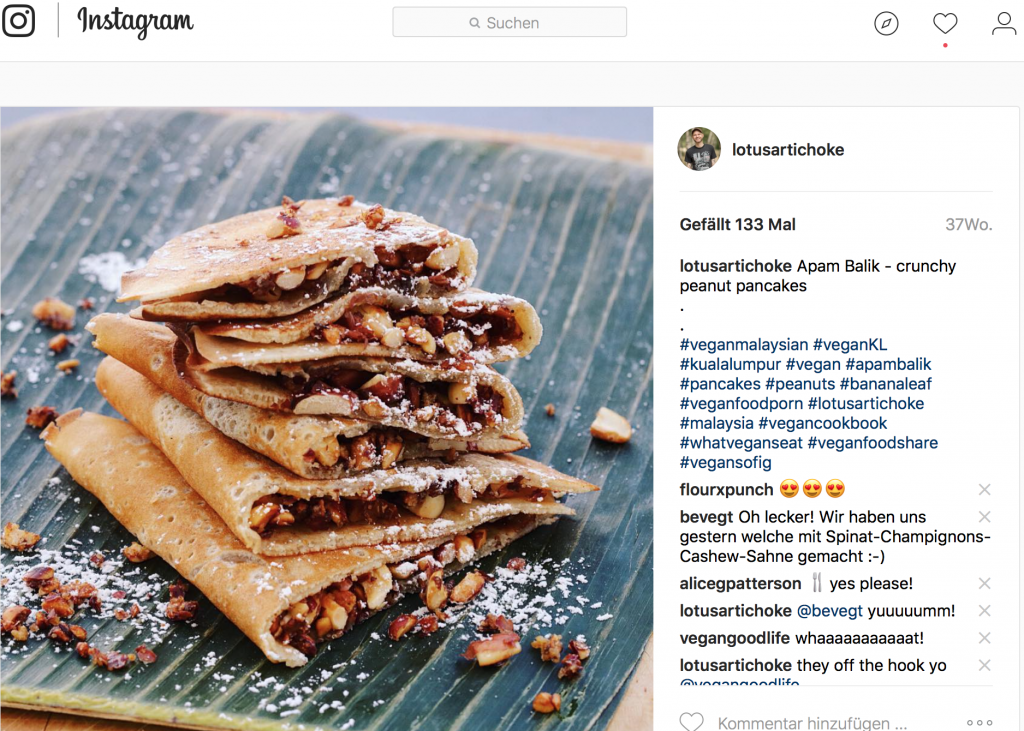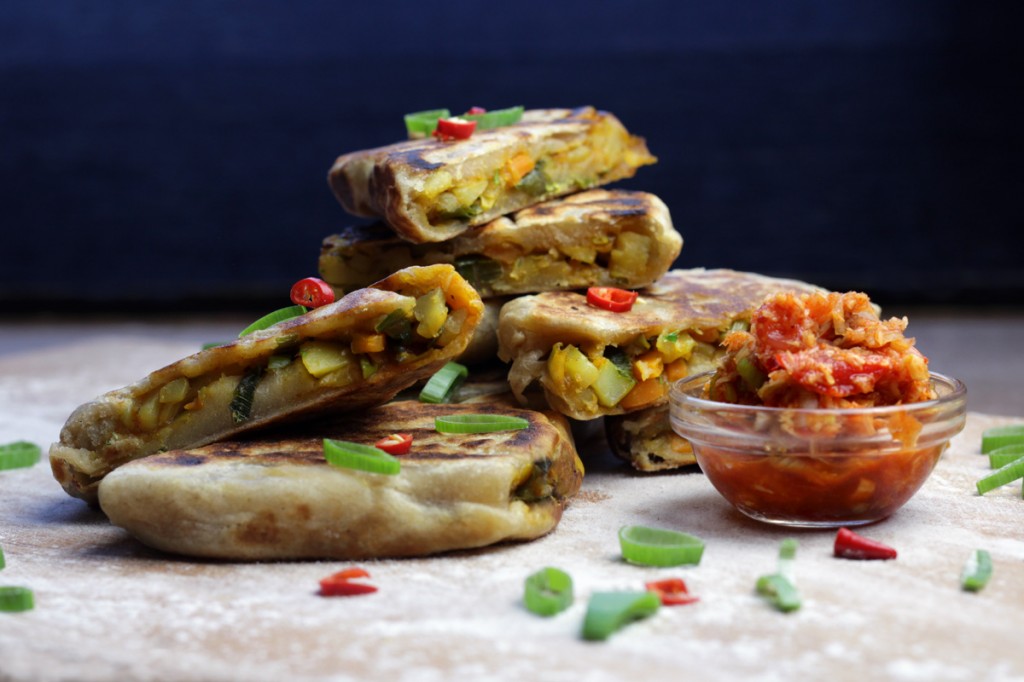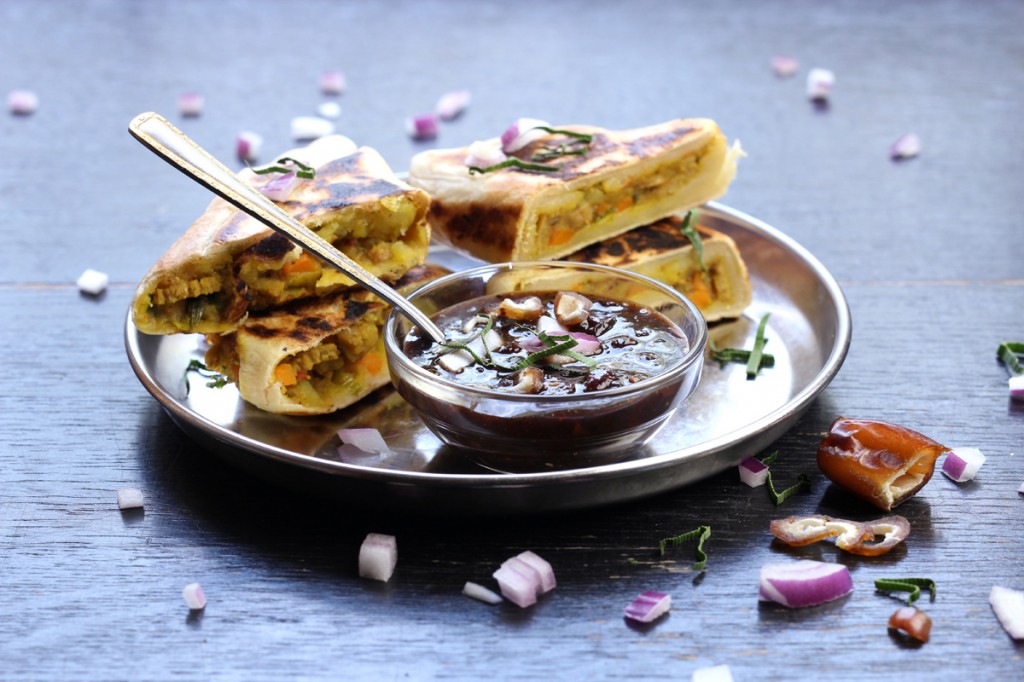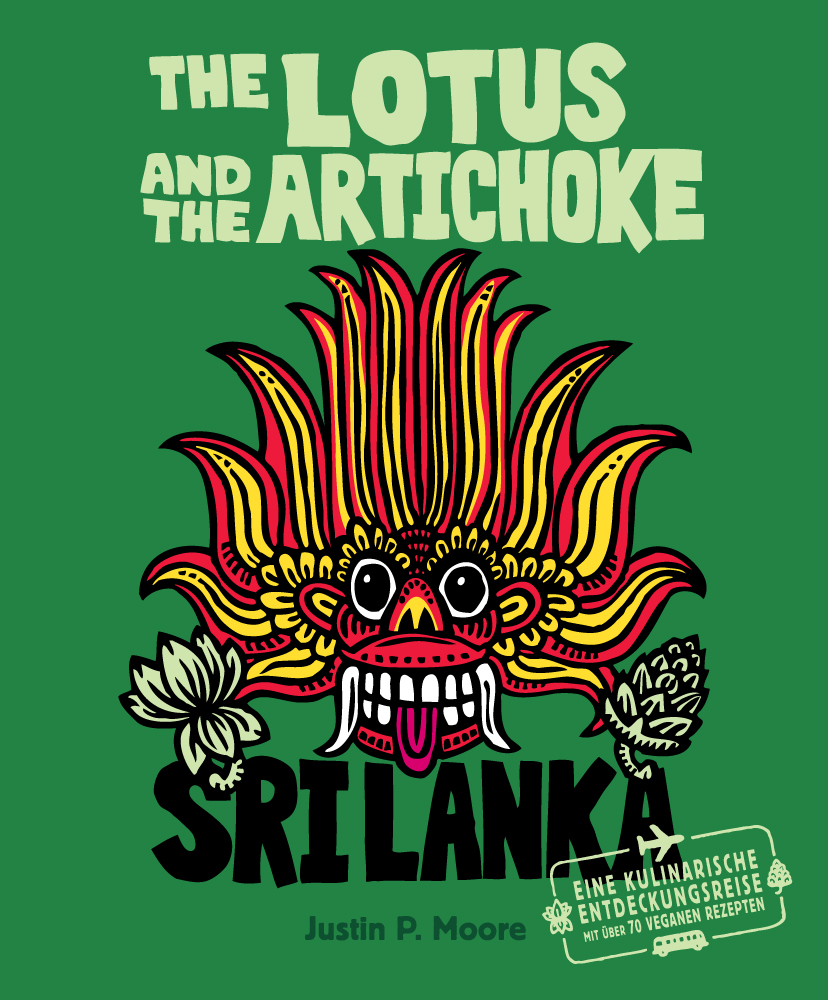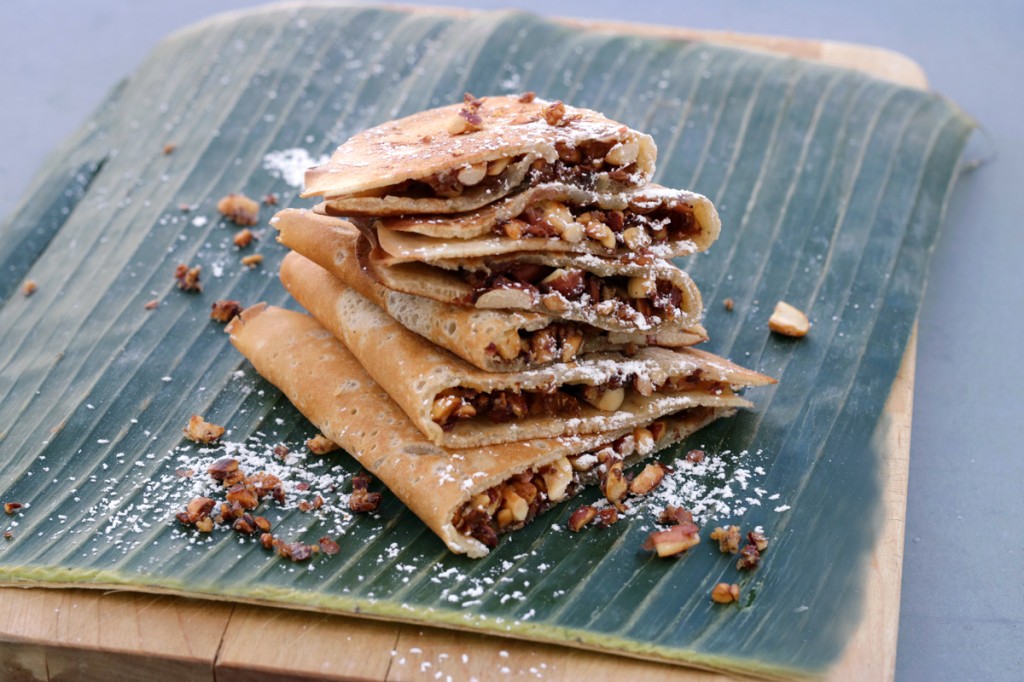
It was my first day in Kuala Lumpur…
I’d just arrived and was at the start of a 5 week culinary adventure to get a taste of Malaysia, Singapore, and Borneo. The sun shone bright and the sky was that deep, satisfying shade of blue. I was on a short morning walk from the Winsin Hotel on the edge of downtown Chinatown, heading towards the Indian neighborhood.
Just outside the subway station on a particularly more urban street corner was a line of shiny, silver food trucks. My eye was caught immediately by one in particular: A woman was spilling roasted, candied peanuts and then corn kernels from a can onto a golden, round, thin pancake. She folded it over – making sort of a sweet taco – and placed it on a rack on the chrome counter of her street food cart. She caught me watching and smiled.
“Hey Mister! You try Apam Balik!”
Well, what could I say? I got closer and watched her make another two crepes. First, she stirred a simple batter of mostly rice flour and coconut milk and poured and spread the crepe on the sizzling griddle. Moments later, she pried up an edge, slid her spatula tracing under the circle, and flipped it over. I watched her again top the thin, crunchy crepes with peanuts and corn before folding them in half and setting them on the rack just in front of me.
Just then, a colorfully dressed Indian woman parted from a few family members and approached the cart from my side. She reached out an anxious hand in a dance-like gesture, rattling rows of wrist bangles, and scooped two of the Apim Balik pancakes from the rack. She rattled off a few sentences in Malay to the seller, they exchanged some money, and both giggled briefly. The Indian woman turned to me and extended one of the crepes until it was right in my face. She said to me in melodic Indian English:
“This one for you. Apam Balik. Peanut Pancake!”
It was in my grasp and between my teeth before I knew it. The crepe was crunchy on the outside but then soft and chewy, quickly giving way to the delightful combination of sweet and salty flavors from the roasted peanuts, punctuated by bursts of fresh corn juiciness. It was perfect. I devoured the rest of it.
Weeks later, back in Berlin, I set about to re-create the deliciousness.
For the vegan recipe in my MALAYSIA cookbook, I made a simple, sure-fire formula for making Apim Balik at home in the kitchen. I didn’t have to veganize anything. It’s a pretty much straight-up thin pancake batter based on rice flour, coconut milk and sugar, lending a crunchy thin crepe. For the filling, I simplified it going with just candied peanuts. My variations (below) include optionally topping it with a sweet syrup and going authentic street food style with sweet corn kernels.
Apam Balik
crispy, crunchy peanut-filled pancakes
recipe from The Lotus and the Artichoke – MALAYSIA
makes 4 to 6 / time 30 min +
- 3/4 cup (100 g) peanuts crumbled or very coarsely ground
- 2 Tbs sugar
- 1/4 tsp sea salt
- 1/2 cup (60 g) flour (all purpose / type 550)
- 1/2 cup (50 g) rice flour
- 1/4 cup (45 g) sugar
- 1 Tbs corn starch
- 1 tsp baking powder
- 1/2 tsp sea salt
- 1 cup (240 ml) coconut milk
- 2 Tbs water
- agave syrup or coconut (palm) syrup optional
- vegetable oil for frying pan
- Crumble or coarsely grind peanuts and dry roast in a pan on medium heat until golden brown and dark spots appear, 4–5 min. Add sugar and salt. Mix well. Stirring constantly, roast until sugar melts and mix starts to stick together, 1–2 min. Remove from heat.
- Combine flour, rice flour, sugar, corn starch, baking powder, and salt in a large mixing bowl. Whisk in coconut milk and water gradually. Mix until mostly smooth, but do not over mix. Cover and let batter sit 20–30 min.
- Heat frying pan on medium high heat. Put a few drops of oil on pan and rub it around with a paper towel. Do this before each pancake. When a drop of water sizzles and dances on surface, pan is ready.
- Pour about 1/4 to 1/3 cup (60–80 ml) batter in the center of the hot pan. Tilt and turn the pan to form a large, thin, circular pancake.
- After bubbles appear on surface and underside is golden brown (about 2–3 min), use a spatula to carefully peel up the edges around the pancake and then flip it over. Cook the other side for 1–2 min, then flip it back over. Put 2–3 Tbs of the sugary peanuts on the pancake and roll up or fold over. Transfer to a plate. Repeat with other pancakes.
- Serve plain, or drizzle pancakes with agave syrup or coconut syrup.
Variations:
Creamy: Use peanut butter instead of roasted, crumbled peanuts. Bananas: Add sliced banana to filling. Traditional: Add 1–2 Tbs sweet corn kernels to each pancake filling.
vegan recipe from The Lotus and the Artichoke – MALAYSIA available in English & German
Apam Balik
knusprige Pancakes mit süßer Erdnussfüllung
Rezept aus The Lotus and the Artichoke – MALAYSIA
4 bis 6 Portionen / Dauer 30 Min. +
- 3/4 Tasse (100 g) Erdnüsse klein gehackt oder grob gemahlen
- 2 EL Zucker
- 1/4 TL Meersalz
- 1/2 Tasse (65 g) Mehl (Type 550)
- 1/2 Tasse (50 g) Reismehl
- 1/4 Tasse (50 g) Zucker
- 1 EL Speisestärke
- 1 TL Backpulver
- 1/2 TL Meersalz
- 1 Tasse (240 ml) Kokosmilch
- 2 EL Wasser
- Pflanzenöl zum Ausbacken
- Agaven– oder Kokosblütensirup wenn gewünscht
- Erdnüsse klein hacken oder grobmahlen und 4 bis 5 Min. in einer Pfanne auf mittlerer Flamme rösten, bis sie goldbraun werden und dunkle Flecken bekommen. Zucker und Salz einrühren. 1 bis 2 Min. unter ständigem Rühren rösten, bis der Zucker schmilzt und die Mischung klebrig wird. Vom Herd nehmen.
- Mehl, Reismehl, Zucker, Speisestärke, Backpulver und Salz in einer großen Schüssel vermischen. Nach und nach Kokosmilch und Wasser einrühren. Verrühren, bis ein glatter Teig entsteht, aber nicht zu lange rühren. Abdecken und Teig 20 bis 30 Min. ruhen lassen.
- Pfanne auf mittlerer Flamme erhitzen. Einige Tropfen Öl in die Pfanne geben und mit einem Stück Küchenpapier verreiben. Vor jedem Pancake wiederholen. Die Pfanne ist heiß genug, wenn ein Tropfen Wasser zischend auf der Oberfläche herumspringt.
- 1/4 bis 1/3 Tasse (60 bis 80 ml) Teig in die Mitte der heißen Pfanne gießen. Pfanne schwenken, bis ein dünner kreisförmiger Pfannkuchen entsteht.
- 2 bis 3 Min. backen, bis auf der Oberfläche Bläschen entstehen und die Unterseite goldbraun ist. Pancake an den Rändern mit einem Pfannenwender anheben und vorsichtig wenden. Unterseite 1 bis 2 Min. backen und Pancake erneut wenden. 2 bis 3 EL der süßen Erdnussfüllung auf den Pancake geben und umschlagen oder aufrollen. Auf einen Teller geben. Restliche Pancakes zubereiten.
- Pur servieren oder mit Agaven– oder Kokosblütensirup beträufeln.
Variationen:
Cremig: Statt zerkleinerter Erdnüsse Erdnussbutter verwenden. Bananen: Bananenscheibchen zur Füllung geben. Traditionell: 1 bis 2 EL Zuckermaiskörner unter die Füllung rühren.
Rezept aus The Lotus and the Artichoke – MALAYSIA

